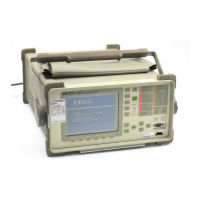3
Setting the Interfaces
Setting PDH Transmit Interface
HOW TO: 1 Choose the required PDH SIGNAL rate.
If Option 110 is fitted, rates of 34Mb/s, 2Mb/s, DS1 and DS3 are
available. If Option UKJ is fitted rates of 2, 8, 34 and 140 Mb/s are
available.
2 If Option UH3, Binary Interfaces is fitted, choose the INTERFACE
required. See "Setting PDH Transmit Binary Interface " page 4.
3 Choose the required clock synchronization source (CLOCK SYNC).
If Option UH3, Binary Interfaces is fitted, the clock can be derived
from an external binary input.
If Option A3K, Jitter and Wander Generator, is fitted and 2 Mb/s
Signal rate is chosen the clock can be derived from an external 2 Mb/s
signal connected to the 2M REF IN port of the Jitter Generator
module.
4 If you have chosen 2 Mb/s as the PDH signal rate, choose the required
impedance (TERMINATION). At all other rates the impedance is
fixed. See Option Differences on previous page.
5 If you have chosen 2 Mb/s, DS1 or 8 Mb/s as the PDH signal rate,
choose the required coding (Line Code). At 34 Mb/s and 140 Mb/s
coding is fixed.
See Option Differences.
6 If required choose the FREQUENCY OFFSET value.
See “Adding Frequency Offset to SONET Signal” page 37
7 Choose the required Payload Type.
If Structured is chosen the PDH test signal must be set up. See
“Setting Transmit Structured Payload/Test Signal (Options UKJ or
110)” page 43.
If you have chosen 2 Mb/s as the PDH signal rate, the Framed choice
is expanded to provide a menu of 2 Mb/s framing types.
8 Choose the PATTERN type and PRBS POLARITY.
Artisan Technology Group - Quality Instrumentation ... Guaranteed | (888) 88-SOURCE | www.artisantg.com

